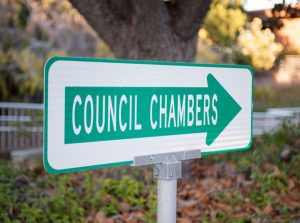In coming weeks the Santa Clara City Council will take up a proposal to formally apologize to Santa Clara residents for the Council’s stubborn fight against changing its 50-year-old at-large by-seat election system — culminating in the $5 million California Voting Rights Act (CVRA) lawsuit the City lost twice. When Council Member Anthony Becker introduced this idea, Mayor Lisa Gillmor wanted to know who was apologizing to whom and for what.
Here’s some history to explain the apology she, Doyle and her allies owe residents for resisting the law and spending $5.8 million on litigation; money that would significantly mitigate budget deficits, including public safety budget cuts that Gillmor deplores.
The City’s record is one of doggedly passing up every opportunity to avoid costly litigation.
Kicking the Can Down the Road
The story starts in 2011 when civil rights attorney Robert Rubin advised Santa Clara that its at-large by-seat election system violated CVRA by diluting the votes of the City minority-majority, the Council appointed a charter review committee. But it dismissed its recommendations to eliminate numbered seats, vaguely promising future discussion after the 2012 election.
The Council appointed another committee to look at the election system in 2015, when then City Attorney Ren Nosky persuaded former Mayor Jamie Matthews that the City risked a CVRA lawsuit.
After Matthews resigned in early 2016 and Gillmor was appointed mayor in his stead, the Council-appointed committee hastily ditched the election question — arguing in February that it was “too much to accomplish before the [Nov. 2016] election.”
Ignoring the CVRA lawsuit threat didn’t make it go away. In Oct. 2016 Robert Rubin sent the City another warning letter, which the Council tried to bury.
Protecting a System That Protected Politics as Usual
In early 2017 the promised lawsuit arrived. The Council’s response was to mount a courtroom defense of a system that city demographics made increasingly indefensible. While neighboring cities’ councils started in the 1980s, 1990s and 2000s reflecting the Bay Area’s demographics, an Old Guard still controlled Santa Clara’s Council — sometimes with multiple generations successively occupying Council seats.
Gillmor and City Attorney Brian Doyle — who believes, contrary to the plain language of state law, that the CVRA doesn’t apply to charter cities — went to court with attorney Steve Churchwell, who had no CVRA litigation experience. What Churchwell did have, however, was a business partnership with Related Companies lobbyist Jude Barry, generally believed to be a Gillmor political advisor.
The Council could, at that point, have changed the election system by ordinance — state law explicitly allows this — and faced a maximum cost of $30,000. Instead, they reseated the same committee that dodged its job the last time.
The committee spent much time discussing Santa Clara exceptionalism and little discussing financial risk. It came up with a proposal for creating two multi-member districts with cutting the City in half and electing three council members in each half, using ranked choice voting and a weighted vote counting method virtually unused in the U.S. (Measure A). Only one committee member, Rex MacIntosh, objected to the proposal.
The fact that this arcane counting system couldn’t be implemented, meant that what was being proposed was actually two multimember districts — another at-large system that could be reasonably expected to deliver the same results as the City’s 50-year-old at-large system.
The Council majority heartily endorsed the idea. If implemented, the plaintiffs assured the City, the City would face a second voting rights lawsuit. Measure A lost, 52 percent to 48 percent.
Cost to the City at this point was about $200,000 for a failed ballot measure and over $500,000 to Attorney Churchwell for his defense argument that an all-White City Council in a minority-majority city didn’t mean that minority residents didn’t elect candidates of their choice.
In June 2018, Judge Thomas Kuhnle ruled against the City, noting Santa Clara’s repeated failure to act in the face of multiple warnings. The plaintiffs were awarded a little over $3 million in legal fees. The cost was now nearly $4 million.
Kuhnle directed the City to implement single member districts in time for the 2018 election. Gillmor and Doyle complained the judge hadn’t allowed enough time to assess public opinion and Churchwell sent a defiant response to the judge. Kuhnle responded by threatening to block election certification. [cvra remedy judge comment 6-26-2018].
Paying the $5.8 Million Piper
The City held by-district elections in 2018 — and appealed the judgment. This time Santa Clara’s argument was that Kuhnle decided the case wrongly because he defined “usually” incorrectly. The appeal would increase Churchwell’s payday to $1.5 million.
The Council appointed a fourth committee to change the charter — with only one minority member out of seven, and Gillmor fought that appointment — and conducted a survey of voter sentiment. The survey showed that 66 percent of those surveyed preferred the six single-member districts.
Survey results were ignored — then-Council Member Debi Davis dismissed the survey saying “data can be manipulated” while Council Member Kathy Watanabe questioned the validity of the numbers. Only 23 percent of those surveyed liked three multi-seat districts.
Yet 3 to 2 was what five of the seven Council-appointed Charter Review committee members approved, with Chair Suds Jain and Committee Member Christine Koltermann opposing.
This second likely illegal at-large system was nonetheless a hit with Gillmor and her Council allies and the new at-large proposal, Measure C, was added to the March 2020 ballot with text its opponents called “deceptive.” The measure proposed the current court-ordered six single member districts for the 2020 election, with a change to the three at-large districts in 2022.
Doyle attacked the measure’s opponents on social media, calling them “naïve” and implying they were being hoodwinked by the 49ers. Measure C lost by more than Measure A — 61 percent to 39 percent. Another $200,000 was added to the tab, now well over $4 million.
Shortly after the new Council was seated in December 2020, Rubin made the City a settlement offer. Doyle not only didn’t inform the Council that Rubin had made the offer, he denied there were new developments in the case when, in fact, he had received the offer days before.
The City’s cost would have been $1 million less had the offer been accepted. But Doyle choreographed a procedural do-se-do to postpone discussion until the afternoon before the hearing.
The appeals court upheld precedent and ruled against the City, panning Santa Clara’s “usually” argument with the words, by saying that the arguments “do not assist its case.” The City finally agreed to settle with the plaintiffs for about $4.2 million, bringing the final bill to $5.8 million.
Ten years ago no City had ever won a CVRA lawsuit or appeal. A decade later, all that’s changed is that Santa Clara now holds a top spot on the CVRA biggest loser list.












Instead of a bunch of empty words it would be better if the people responsible demonstrated that they were truly sorry by resigning.